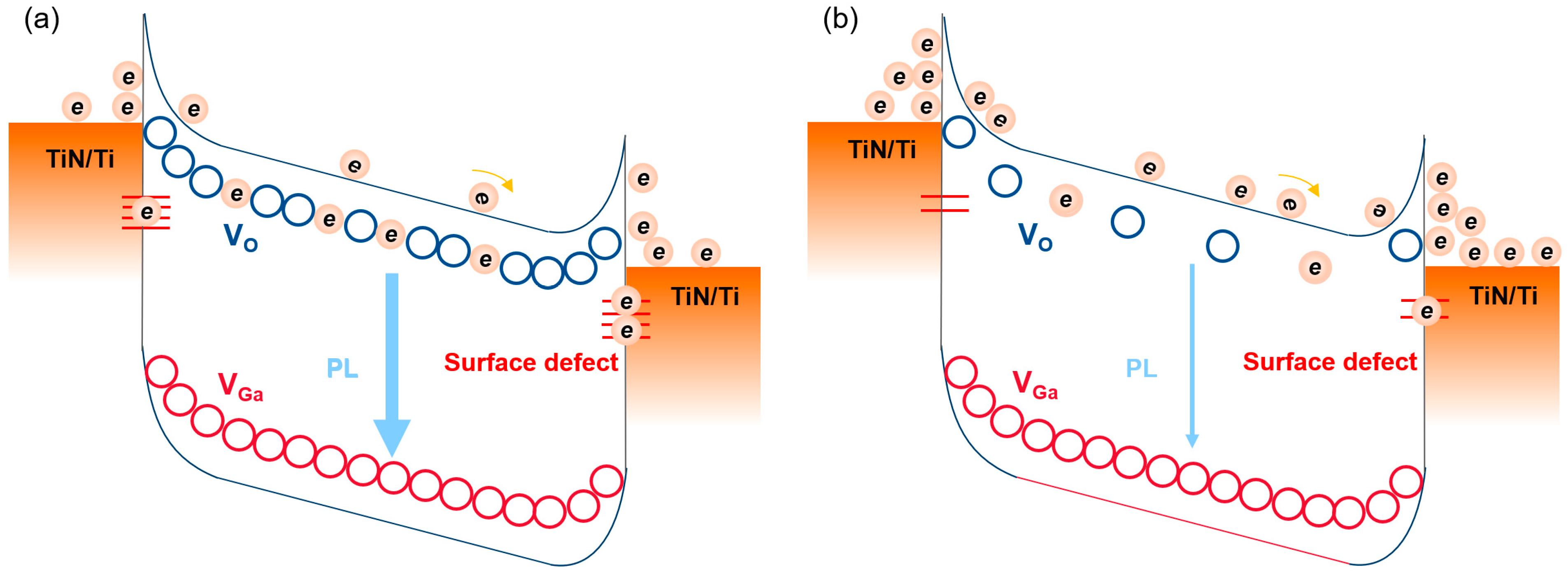Plasma Nitridation Effect on β-Ga2O3 Semiconductors
Abstract
:1. Introduction
2. Materials and Methods
2.1. Formation of Polycrystalline β-Ga2O3 and PN Treatment Process
2.2. Characterization of β-Ga2O3 after PN Process
2.3. Metal-β-Ga2O3 Semiconductor-Metal (MSM) Photodetector (PD)
3. Results and Discussion
4. Conclusions
Author Contributions
Funding
Institutional Review Board Statement
Informed Consent Statement
Data Availability Statement
Conflicts of Interest
References
- Pearton, S.J.; Yang, J.; Cary, P.H., IV; Ren, F.; Kim, J.; Tadjer, M.J.; Mastro, M.A. A review of Ga2O3 materials, processing, and devices. Appl. Phys. Rev. 2018, 5, 011301. [Google Scholar] [CrossRef] [Green Version]
- Guo, D.; Guo, Q.; Chen, Z.; Wu, Z.; Li, P.; Tang, W. Review of Ga2O3-based optoelectronic devices. Mater. Today Phys. 2019, 11, 100157. [Google Scholar] [CrossRef]
- Chen, X.; Ren, F.; Gu, S.; Ye, J. Review of gallium-oxide-based solar-blind ultraviolet photodetectors. Photonics Res. 2019, 7, 381–415. [Google Scholar] [CrossRef]
- Yoon, Y.; Kim, S.; Lee, I.G.; Cho, B.J.; Hwang, W.S. Electrical and photocurrent properties of a polycrystalline Sn-doped β-Ga2O3 thin film. Mater. Sci. Semicond. Process 2021, 121, 105430. [Google Scholar] [CrossRef]
- Wang, J.; Xiong, Y.; Ye, L.; Li, W.; Qin, G.; Ruan, H. Balanced performance for β-Ga2O3 solar blind photodetectors: The role of oxygen vacancies. Opt. Mater. 2021, 112, 110808. [Google Scholar] [CrossRef]
- Guo, D.; Wu, Z.; Li, P.; An, Y.; Liu, H.; Guo, X. Fabrication of β-Ga2O3 thin films and solar-blind photodetectors by laser MBE technology. Opt. Mater. 2014, 4, 1067–1076. [Google Scholar] [CrossRef]
- Guo, D.Y.; Wu, Z.P.; An, Y.H.; Guo, X.C.; Chu, X.L.; Sun, C.L. Oxygen vacancy tuned Ohmic-Schottky conversion for enhanced performance in β-Ga2O3 solar-blind ultraviolet photodetectors. Appl. Phys. Lett. 2014, 105, 023507. [Google Scholar] [CrossRef]
- Arora, K.; Goel, N.; Kumar, M.; Kumar, M. Ultrahigh performance of self-powered β-Ga2O3 thin film solar-blind photodetector grown on cost-effective Si substrate using high-temperature seed layer. Acs Photonics 2018, 5, 2391–2401. [Google Scholar] [CrossRef]
- Zhou, H.T.; Cong, L.J.; Ma, J.G.; Chen, M.Z.; Song, D.Y.; Wang, H.B. Recent progress of graphene-based photoelectrode materials for dye-sensitized solar cells. J. Alloys Compd. 2020, 847, 156536. [Google Scholar] [CrossRef]
- Xu, R.; Ma, X.; Chen, Y.; Mei, Y.; Ying, L.; Zhang, B.; Long, H. Effect of oxygen vacancies in heteroepitaxial β-Ga2O3 thin film solar blind photodetectors. Mater. Sci. Semin. Proc. 2022, 144, 106621. [Google Scholar] [CrossRef]
- Stepanov, S.I.; Nikolaev, V.I.; Bougrov, V.E.; Romanov, A.E. Epitaxial growth of (2 01) β-Ga2O3 on (0001) sapphire substrates by halide vapour phase epitaxy. Adv. Mater. Sci. 2016, 44, 63–68. [Google Scholar]
- Jankovic, N. Numerical simulations of N-type CdSe poly-TFT electrical characteristics with trap density models of Atlas/Silvaco. Microelectron. Reliab. 2012, 52, 2537–2541. [Google Scholar] [CrossRef]
- Misra, D. Charge-trapping properties of gate oxide grown on nitrogen-implanted silicon substrate. Appl. Phys. Letts. 1999, 75, 2283. [Google Scholar] [CrossRef]
- Dai, M.; Wang, Y.; Shepard, J. Effect of plasma N2 and thermal NH3 nitridation in HfO2 for ultrathin equivalent oxide thickness. J. Appl. Phys. 2013, 113, 044103. [Google Scholar] [CrossRef]
- Park, K.S.; Baek, K.H.; Kim, D.P.; Woo, J.C.; Do, L.M.; No, K.S. Effects of N2 and NH3 remote plasma nitridation on the structural and electrical characteristics of the HfO2 gate dielectrics. Appl. Surf. Sci. 2010, 257, 1347–1350. [Google Scholar] [CrossRef]
- Park, H.B.; Cho, M.J.; Park, J.H. Effects of plasma nitridation of Al2O3 interlayer on thermal stability, fixed charge density, and interfacial trap states of HfO2 gate dielectric films grown by atomic layer deposition. J. Appl. Phys. 2003, 94, 1898. [Google Scholar] [CrossRef]
- Wang, L.; Xu, J.; Liu, L.; Lu, H.; Lai, P. Design of GeSn-based heterojunction-enhanced N-channel tunneling FET with improved subthreshold swing and ON-state current. IEEE Trans. Electron Device 2015, 62, 1235–1240. [Google Scholar]
- Makuła, P.; Pacia, M.; Macyk, W. How to correctly determine the band gap energy of modified semiconductor photocatalysts based on UV–Vis spectra. J. Phys. Chem. Lett. 2018, 9, 6814–6817. [Google Scholar] [CrossRef] [Green Version]
- Chang, K.-W.; Wu, J.-J. Low-Temperature Growth of Well-Aligned β-Ga2O3 Nanowires from a Single-Source Organometallic Precursor. Adv. Mater. 2004, 16, 545–549. [Google Scholar] [CrossRef]
- Tien, L.-C.; Chen, W.-T.; Ho, C.-H. Enhanced photocatalytic activity in β-Ga2O3 nanobelts. J. Am. Ceram. Soc. 2011, 94, 3117–3122. [Google Scholar] [CrossRef]
- Wei, J.; Shi, F. Synthesis and characterization of Sn-doped β-Ga2O3 nano-and micrometer particles by chemical vapor deposition. J. Mater. Sci. Mater. Electron. 2016, 27, 942–946. [Google Scholar] [CrossRef]




Disclaimer/Publisher’s Note: The statements, opinions and data contained in all publications are solely those of the individual author(s) and contributor(s) and not of MDPI and/or the editor(s). MDPI and/or the editor(s) disclaim responsibility for any injury to people or property resulting from any ideas, methods, instructions or products referred to in the content. |
© 2023 by the authors. Licensee MDPI, Basel, Switzerland. This article is an open access article distributed under the terms and conditions of the Creative Commons Attribution (CC BY) license (https://creativecommons.org/licenses/by/4.0/).
Share and Cite
Kim, S.; Kim, M.; Kim, J.; Hwang, W.S. Plasma Nitridation Effect on β-Ga2O3 Semiconductors. Nanomaterials 2023, 13, 1199. https://doi.org/10.3390/nano13071199
Kim S, Kim M, Kim J, Hwang WS. Plasma Nitridation Effect on β-Ga2O3 Semiconductors. Nanomaterials. 2023; 13(7):1199. https://doi.org/10.3390/nano13071199
Chicago/Turabian StyleKim, Sunjae, Minje Kim, Jihyun Kim, and Wan Sik Hwang. 2023. "Plasma Nitridation Effect on β-Ga2O3 Semiconductors" Nanomaterials 13, no. 7: 1199. https://doi.org/10.3390/nano13071199
APA StyleKim, S., Kim, M., Kim, J., & Hwang, W. S. (2023). Plasma Nitridation Effect on β-Ga2O3 Semiconductors. Nanomaterials, 13(7), 1199. https://doi.org/10.3390/nano13071199








